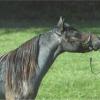Coat Colors and Domestication
duncentralstation
June 11, 2010 February 22, 2011
Forums
Several months ago a friend of mine sent me a copy of a published scientific article titled, "Coat Color Variation at the Beginning of Horse Domestication," published April 24, 2009 in [i]Science[/i] magazine.
[size=85]
[color=#0080FF]Researchers/authors are affiliated with various institutes and universities in Germany, Spain, and USA (University of California Berkeley) ... involving zoologists, anthropologists, and biologists. If anyone requires it, I can type out the list of authors and which institutions or universities with which they are affiliated.[/color][/size]
In this article they say there is evidence that horses were domesticated as early as 5,500 to 5,000 BP (before present ... before the year 0). And that coat color variations began to take place quite rapidly from that point in time ... with human selection being credited for that rapid change.
Another friend pointed out to us at that time that breeders of fox noticed a rapid change in colors produced by the captive fox. Due to human selection in the breeding process, colors that would likely not have survived in the wild (hence were not seen in wild/free fox) were not uncommon in captive bred foxes. I think she said even parti-colored (think pinto) patterns were seen quite regularly.
Using ancient samples (DNA from the remains of ancient horses), the researchers who authored of the above mentioned article were able to determine that the earliest ancient horses were all at least bay (EE AA) ... from around 12,000 BP, if I'm reading it correctly.
Bear in mind that they could only test for colors for which there is currently a direct DNA test for that gene/mutation. In other words, they had no dun test available to them, for example, so they could not test for dun. They do state that there is evidence they were all bay dun, but that they couldn't test for dun.
It was shortly after they believe horses to have first become domesticated (around 5,000 - 4,000 BP, I guess) that they first note both "A" and "a" present in early Iberian horses. So that's when black coat phenotype became possible ... that's when an "A" mutated to an "a"!
Around the 2,000 BP-ish time frame (I'm not reading to get exact dates, just looking at a linear time line and paraphrasing), mutations for Tobiano, Sabino, and Chestnut showed up.
And finally in the 1,000 BP time frame, Buckskin and Black Silver were noted.
Obviously, for example, if buckskin and chestnut were possible, so was palomino and all other variants of cream dilution. They are simply reporting what the precise color test results were for the ancient DNA samples they had available to them. In other words, the samples they had just didn't happen to include a palomino. BTW, they had 152 samples, from which they were able to successfully color test 89. The others may not have had viable DNA, I guess.
Thought some of you might find this interesting.
Re: Coat Colors and Domestication
Also, a litter raised in a compound with domestic dogs were ripped apart by the dogs once they reached maturity. To my knowledge a Wolf raised the same way is accepted.
The cave pictures of horses do not show parti coloured horses, or, IMO, spotted ones either, I am pretty sure the "spotted" one is either decoration or a dapple Grey or Roan.
AFAIK, parti coloured horses did not start showing up until domestication took place, and then only in the herds where such patterns were either ignored or valued.


Re: Coat Colors and Domestication
[quote="rabbitsfizz"]African Wild Dogs are not true Dogs....as far as I am aware they are not Lupus or Canis.
But the theory still holds true, except that in their case and in the case of a number of wild, African animals, the white "spotting" is part of the camouflage.
[/quote]
I agree that the AWDs' white spotting is camo, in fact, it's my opinion that white patterning, especially in prey animals, probably developed for camo purposes (i.e., the animals in 'camo' survived longer to spread their genes around better).
As for the AWDs being dogs or not...pass. I just remember a snippet from a doco where some guy who is working to repopulate the AWD packs in the wild (apparently there are very few left in Africa) commenting on their total lack of interest in humans, despite being 100% dependant on them, or being around a human since birth. The big cats are more eligible to become domesticated than AWDs.
Diane